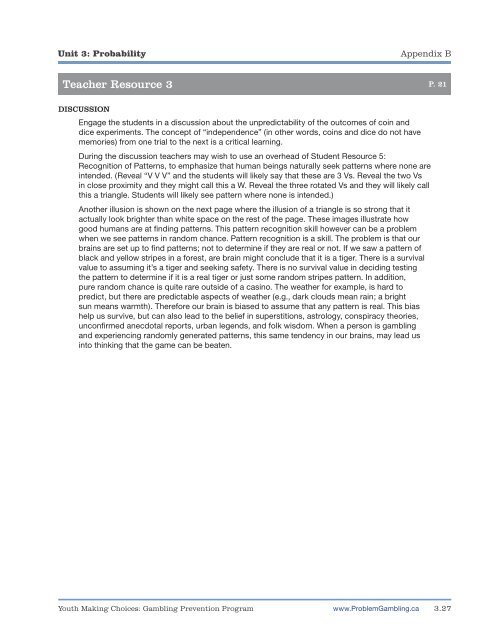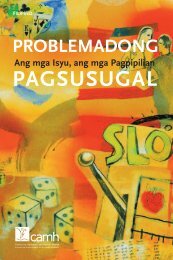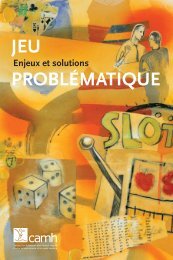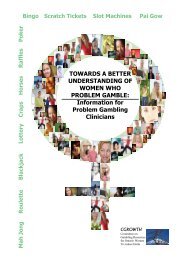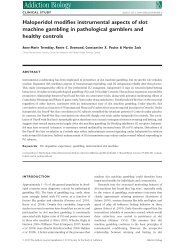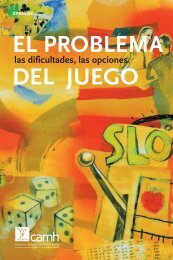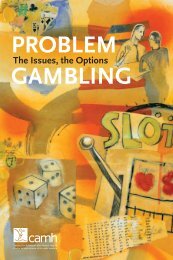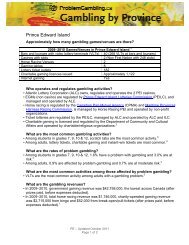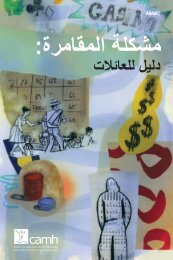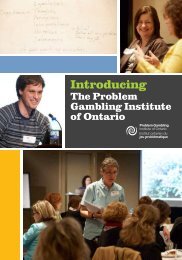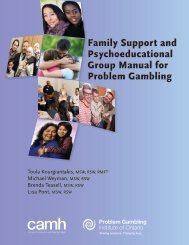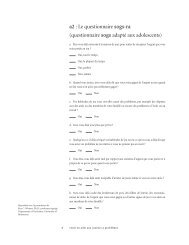Youth Making Choices: Gambling Prevention Program
Youth Making Choices: Gambling Prevention Program
Youth Making Choices: Gambling Prevention Program
You also want an ePaper? Increase the reach of your titles
YUMPU automatically turns print PDFs into web optimized ePapers that Google loves.
Unit 3: ProbabilityAppendix BTeacher Resource 3 p. 21DiscussionEngage the students in a discussion about the unpredictability of the outcomes of coin anddice experiments. The concept of “independence” (in other words, coins and dice do not havememories) from one trial to the next is a critical learning.During the discussion teachers may wish to use an overhead of Student Resource 5:Recognition of Patterns, to emphasize that human beings naturally seek patterns where none areintended. (Reveal “V V V” and the students will likely say that these are 3 Vs. Reveal the two Vsin close proximity and they might call this a W. Reveal the three rotated Vs and they will likely callthis a triangle. Students will likely see pattern where none is intended.)Another illusion is shown on the next page where the illusion of a triangle is so strong that itactually look brighter than white space on the rest of the page. These images illustrate howgood humans are at finding patterns. This pattern recognition skill however can be a problemwhen we see patterns in random chance. Pattern recognition is a skill. The problem is that ourbrains are set up to find patterns; not to determine if they are real or not. If we saw a pattern ofblack and yellow stripes in a forest, are brain might conclude that it is a tiger. There is a survivalvalue to assuming it’s a tiger and seeking safety. There is no survival value in deciding testingthe pattern to determine if it is a real tiger or just some random stripes pattern. In addition,pure random chance is quite rare outside of a casino. The weather for example, is hard topredict, but there are predictable aspects of weather (e.g., dark clouds mean rain; a brightsun means warmth). Therefore our brain is biased to assume that any pattern is real. This biashelp us survive, but can also lead to the belief in superstitions, astrology, conspiracy theories,unconfirmed anecdotal reports, urban legends, and folk wisdom. When a person is gamblingand experiencing randomly generated patterns, this same tendency in our brains, may lead usinto thinking that the game can be beaten.<strong>Youth</strong> <strong>Making</strong> <strong>Choices</strong>: <strong>Gambling</strong> <strong>Prevention</strong> <strong>Program</strong>www.Problem<strong>Gambling</strong>.ca3.27


